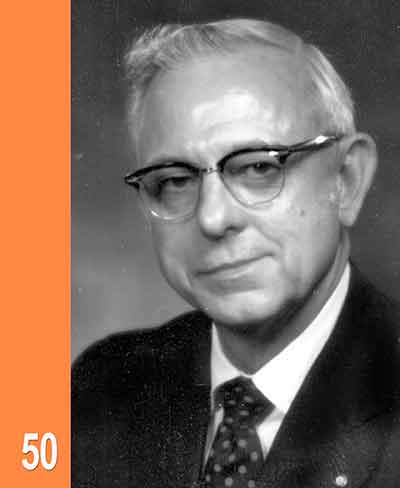James E. Charlet
Induction Year:ČŢ2009
Lived:ČŢ1908-1999
Papers:
Clarksville Leaf-Chronicle; Music City News; Hendersonville Star News
James E. Charlet began his 48-year newspaper career in 1930 as a part-time advertising salesman at the Evening Nashville Tennessean, and by his 1932 cum laude Vanderbilt University graduation this Livermore, Kentucky native was editor-manager of the Business Review Page of the evening and morning Nashville Tennessean.
On February 10, 1940, he was named vice president-general manager of the Clarksville Leaf-Chronicle, where he built and was publisher of Tennesseeĺ─˘s largest family-owned newspaper group comprised of one daily and 16 weekly newspapers in nine Middle Tennessee counties, with circulation exceeding 180,000. Each newspaper voiced independent editorial opinions, focused on community service.
With Europe at war, his September 7, 1940, editorial ĺ─˙Thereĺ─˘s Still Timeĺ─¨ launched the 5th District Congressional career of J. Percy Priest, by condemning the vote of incumbent Rep. Joseph W. Byrns, Jr. against renewal of the U.S. Conscription law, and urging Priestĺ─˘s election as an Independent. On January 7, 1942, The Nashville Tennessean named Charlet as one of two Clarksville leaders who spearheaded efforts to establish the 105,068 acre Fort Campbell military reservation as the U.S. Armyĺ─˘s third largest personnel base.
In November 1942, Charlet purchased the weekly Stewart County Times, moved its production to the Clarksville Leaf-Chronicle plant, and trucked the Times editions to Dover for post office delivery. Thus began his pioneer development of Tennesseeĺ─˘s first newspaper central printing plant, which by 1978 was the Southĺ─˘s largest such newspaper printing facility.
In July 1946, Charlet and his wife, circulation manager Martha C. Charlet, bought half of the Leaf-Chronicle Co. capital stock, and added Associated Press wire services and teletype machines at their four weekly newspapers. In 1949, Charlet installed Tennesseeĺ─˘s first Fairchild Scan-A-Graver to publish local photographs within three hours of news events. By February 1962, his was the first Tennessee daily newspaper to successfully and profitably convert to web offset printing on a 24-page Goss Suburban press, becoming the Southĺ─˘s only web offset central printing plant of daily and weekly newspapers.
In the Age of Mechanics and before Electronics, Charlet introduced ĺ─˙modular manufacturingĺ─¨ and high speed batch processing of news and advertising to Tennesseeĺ─˘s newspaper industry. This involved cluster positioning of typesetting machinery to increase production through-put, and color coding of news and advertising copy. These established production flow priorities that increased newspaper page production rates from a daily average of six (6) pages in 1940, to a daily average of 230 pages in 1978. Employment levels grew from 18 fulltime workers in 1940, to 260 employees in 1978.
Charlet was a director and later president of the Tennessee Press Association in 1960-1961, and developed its ĺ─˙Farming For Profitĺ─¨ editions and ĺ─˙Community Progress Promotionsĺ─¨ in partnership with two Tennessee state government divisions. This produced $71,348 in new advertising revenues for 155 TPA newspapers. He chaired the TPA Legislative Committee in 1944 and 1945, and served on its national advertising, nominating, newspaper ethics committees, and its 1951 Capitol Press committee seeking pressroom workspace for Capitol Hill reporters.
In expanding the economic base of his 16 newspaper markets, Charlet vigorously editorialized on imperatives for community coalitions to diversify their post-World War II agriculture-industrial economies. He chaired the Industrial Development committee of the Clarksville Chamber of Commerce for 23 years, was a member of the Tennessee Industrial Commission, and in 1956 created the ĺ─˙Greater Clarksville Foundationĺ─¨ as a private sector financing tool to purchase industrial plant readiness sites to attract new industries without government subsidies. On May 3, 1957, he successfully recruited to Clarksville the Trane air conditioning plant and its eventual 2,318 employees.
Charlet believed the soul of a strong newspaper is a vigorous editorial page. The ĺ─˙Leaf-Chronicleĺ─˘s Objectivesĺ─¨ topped his daily editorial page, and as each community objective was achieved another succeeded it. His editorials championed legalizing Sunday theater movies (1942), polio vaccination programs (1955), school desegregation (1955), proactive city annexations (1959), city water fluoridation (1961), and city-county school system unification (1963). In his 1967 book ĺ─˙Crisis in Print: Desegregation and the Press in Tennesseeĺ─¨, historian Dr. Hugh Davis Graham declared ĺ─˙ĺ─ÂJames Charletĺ─˘s newspaper editorial influence on social issues extended throughout northwestern Middle Tennessee and nearby Kentuckyĺ─¨.
At retirement, Charlet had increased total assets of his newspaper company from $75,143 in 1940, to $6.1 million in 1978, and pushed total annual sales from $65,348 in 1940, to $7.1 million in 1978.
